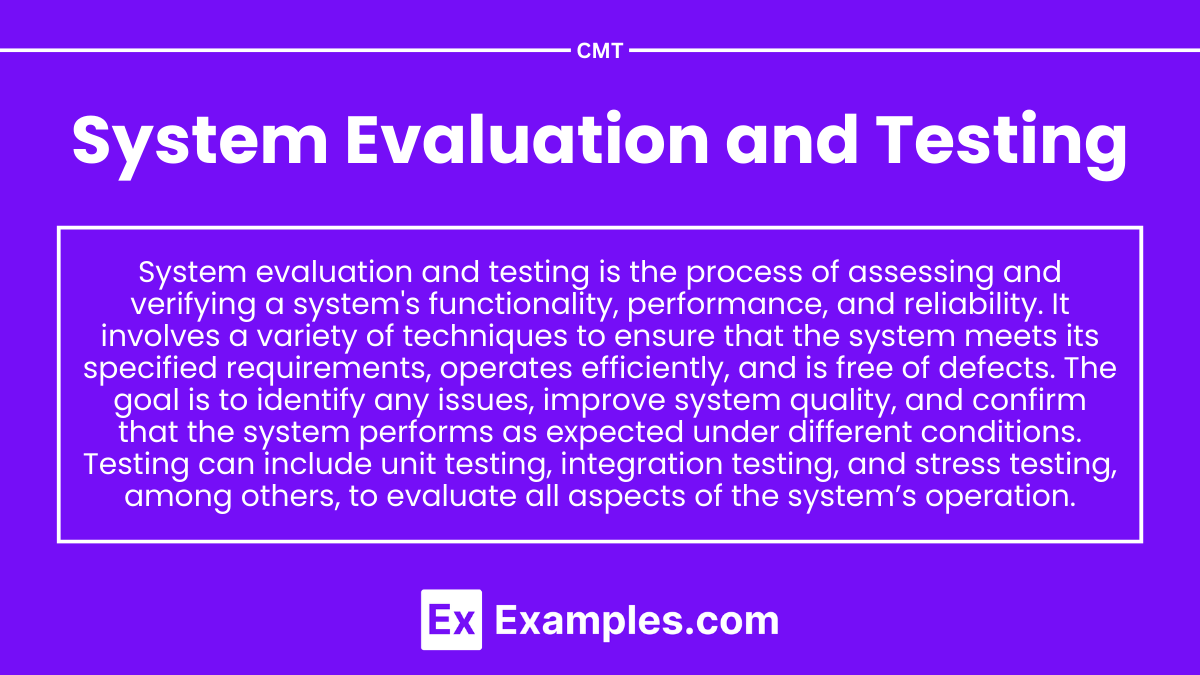Preparing for the CMT Exam requires a solid grasp of System Evaluation and Testing, a key aspect of technical analysis that focuses on assessing the reliability, accuracy, and effectiveness of trading systems. This involves analyzing historical performance, conducting stress tests, and validating predictive models to ensure consistent results in diverse market scenarios. By mastering these techniques, candidates can identify system limitations, optimize algorithms, and enhance trading strategies, ultimately improving portfolio performance and ensuring adaptability to market dynamics.
Learning Objectives
In studying System Evaluation and Testing for the CMT Exam, you should learn to understand its importance in validating trading systems and ensuring their reliability under diverse market conditions. Successful system evaluation requires analyzing backtesting results, identifying overfitting or biases, and applying robust testing methodologies to ensure system performance aligns with expectations. Techniques such as walk-forward analysis, Monte Carlo simulations, and stress testing help assess system adaptability and resilience to market volatility. This process ensures trading systems are optimized, robust, and capable of achieving consistent performance, which is essential for success in the CMT Exam.
What is System Evaluation and Testing?
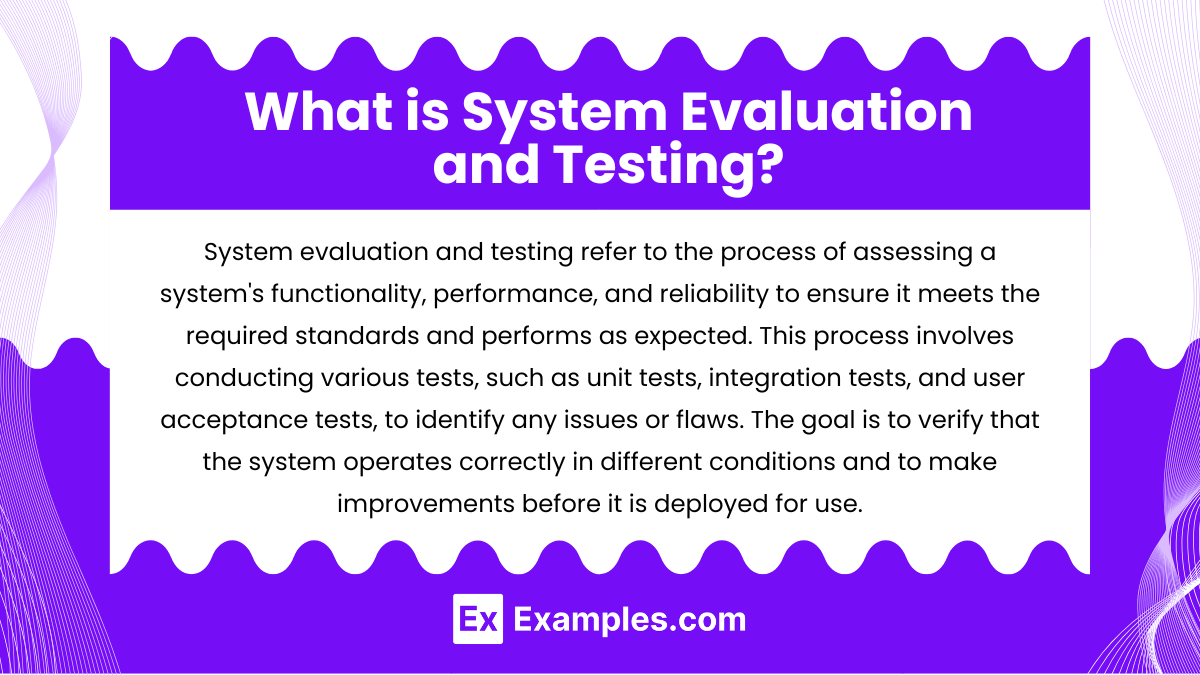
System evaluation and testing refer to the methods used to assess the reliability, performance, and validity of market analysis systems, trading algorithms, and technical indicators. It involves using statistical methods and practical simulations to evaluate how these systems perform under varying market conditions. This is vital for ensuring that technical systems and strategies yield consistent and accurate results.
Purposes of System Evaluation and Testing
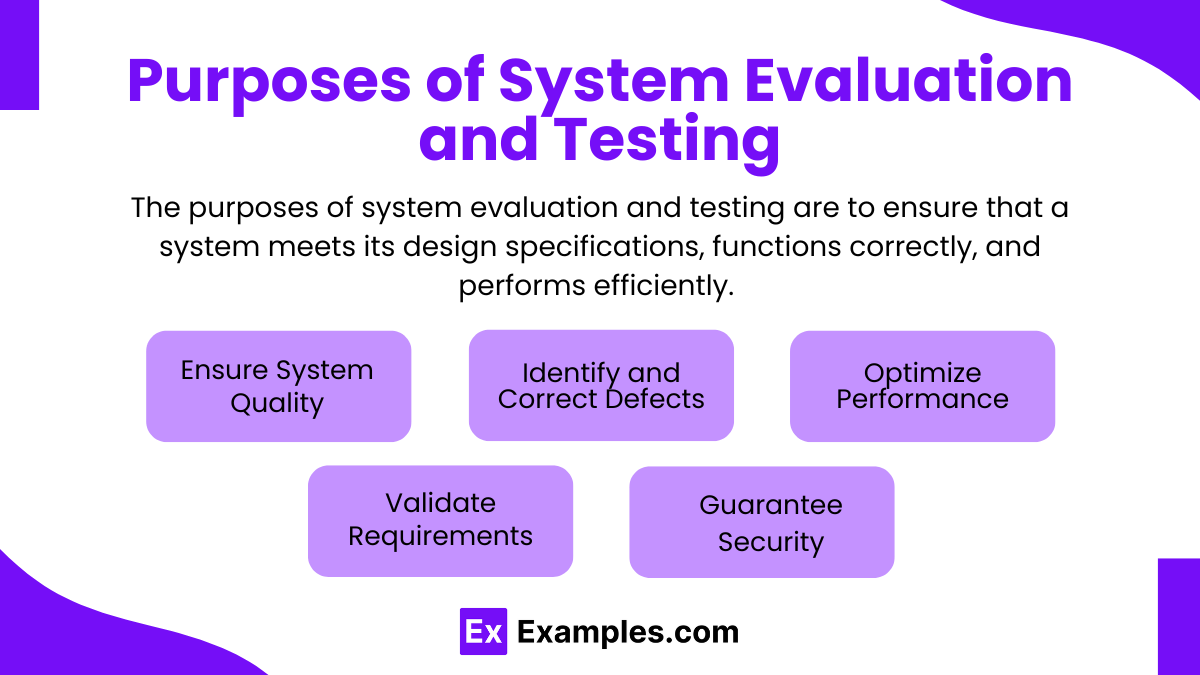
The purposes of system evaluation and testing are to ensure that a system meets its design specifications, functions correctly, and performs efficiently. It helps identify any defects, vulnerabilities, or potential issues in the system before deployment, ensuring reliability and stability. Testing also verifies that the system meets user requirements and complies with relevant standards and regulations.
- Ensure System Quality:
System evaluation and testing verify that the system meets quality standards and is capable of fulfilling its intended purpose. - Identify and Correct Defects:
They help in detecting and rectifying any bugs or issues in the system to improve reliability and performance. - Optimize Performance:
Testing allows for identifying bottlenecks, optimizing resource utilization, and ensuring smooth system operation under varying conditions. - Validate Requirements:
Testing ensures the system meets all the technical and functional requirements as outlined in the design and specification documents. - Guarantee Security:
Security testing helps identify vulnerabilities and ensure the system is protected against unauthorized access and data breaches.
Types of System Evaluation and Testing
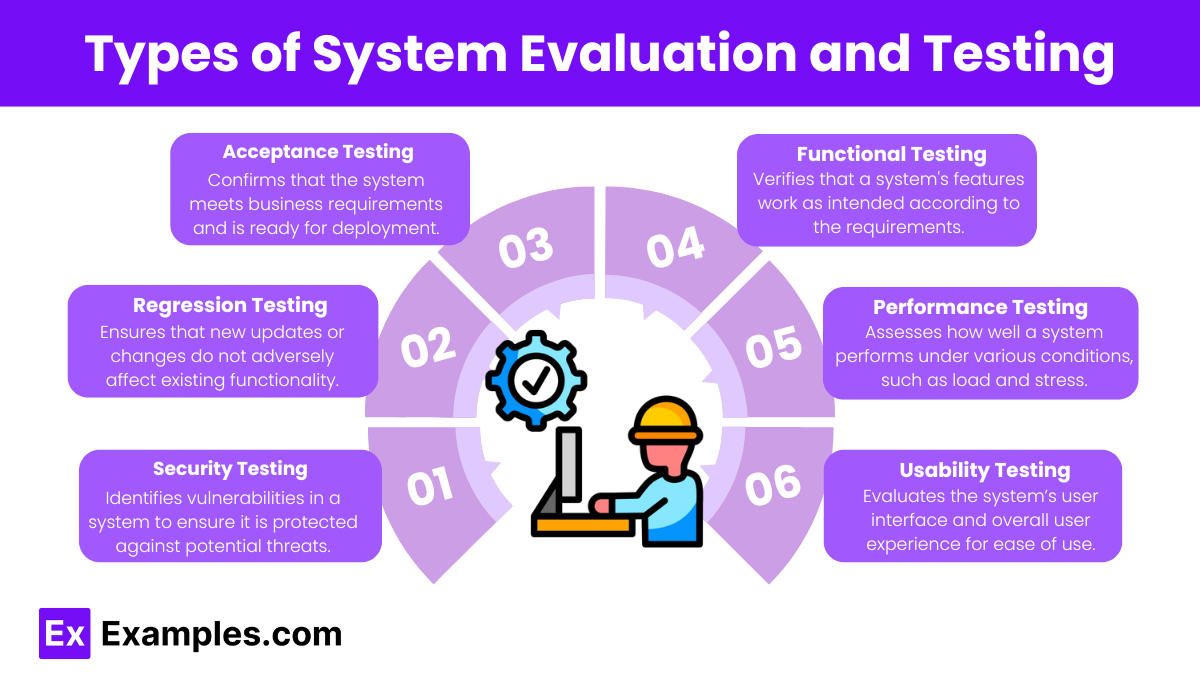
System evaluation and testing are crucial steps in ensuring the functionality, reliability, and quality of a system. There are several types of system evaluation and testing methods, each serving a different purpose. Here are the main types:
- Functional Testing
- Functional testing focuses on verifying that the system performs its intended functions correctly. It evaluates whether the system meets the specified functional requirements and ensures that the features and behaviors work as expected. This type of testing typically includes unit testing, integration testing, and system testing.
- Performance Testing
- Performance testing assesses how well a system performs under various conditions, such as load, stress, and scalability. This type of testing helps identify bottlenecks, measure response times, and determine the system’s ability to handle high traffic or heavy workloads. Common subtypes include load testing, stress testing, and scalability testing.
- Usability Testing
- Usability testing evaluates the system’s user interface and user experience (UI/UX). The goal is to assess how easy and intuitive the system is for users to interact with. This testing typically involves real users or user feedback and helps identify areas where the system can be improved to enhance user satisfaction.
- Security Testing
- Security testing aims to uncover vulnerabilities in a system that could be exploited by malicious actors. It involves assessing the system’s defenses against unauthorized access, data breaches, and other security threats. This type of testing includes penetration testing, vulnerability scanning, and assessing encryption, authentication, and authorization mechanisms.
- Regression Testing
- Regression testing ensures that new changes or updates to the system do not introduce new defects or break existing functionality. This testing is performed after system enhancements, bug fixes, or new features are implemented to verify that previously working features continue to operate as expected.
- Acceptance Testing
- Acceptance testing, often referred to as user acceptance testing (UAT), evaluates whether the system meets the user’s needs and requirements. It is typically performed by end-users and ensures that the system is ready for deployment and can fulfill business objectives. This is usually the final phase before the system goes live.
Techniques of System Evaluation and Testing
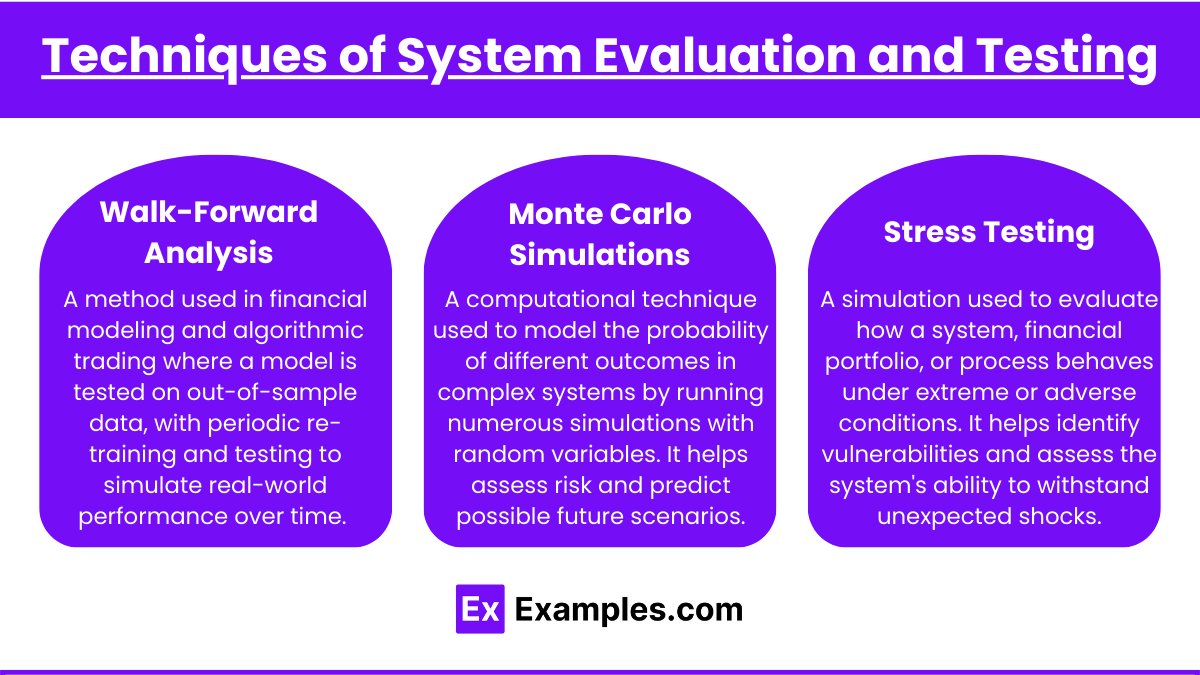
- Walk-Forward Analysis
A method used in financial modeling and trading strategy development where the model is tested on out-of-sample data, moving forward in time in a stepwise manner to ensure robustness and reliability. - Monte Carlo Simulations
A computational technique used to model and simulate the probability of different outcomes in a process that cannot easily be predicted due to the random variables involved. It is widely used for risk analysis and decision-making. - Stress Testing
A simulation technique used to evaluate how a system performs under extreme conditions or hypothetical adverse scenarios. It’s particularly useful in finance and risk management to assess the resilience of systems, portfolios, or organizations.
Examples
Example 1. In Software Development
System evaluation and testing in software development involves analyzing a program’s functionality to ensure it meets the required standards. Testing methods like unit tests, integration tests, and user acceptance testing (UAT) are employed to evaluate the system’s performance under various conditions. It allows developers to identify bugs, errors, or vulnerabilities before the software is deployed for use. Comprehensive testing ensures that the system performs as expected and provides end-users with a reliable product.
Example 2. In Information Security
In information security, system evaluation and testing are crucial for identifying security vulnerabilities and ensuring the integrity of data. Penetration testing and vulnerability assessments are common techniques used to evaluate a system’s defense mechanisms. By simulating potential attacks, security teams can identify weaknesses and patch them before they become a target for cybercriminals. Testing often involves reviewing encryption methods, firewall configurations, and access controls to enhance the overall security posture.
Example 3. In Network Management
For network systems, evaluation and testing are key steps in maintaining a stable and efficient infrastructure. System testing in network management includes stress testing, throughput testing, and latency testing to determine the network’s capability to handle large data transfers. By performing these evaluations, network administrators can ensure that the system can withstand peak traffic loads and detect any points of failure or congestion, ultimately ensuring seamless connectivity.
Example 4. In Healthcare Technology
In healthcare technology, system evaluation and testing are essential for ensuring that medical devices and software meet stringent regulatory standards. For instance, a hospital’s patient management system undergoes rigorous testing to verify that it correctly stores and retrieves patient information, operates securely, and complies with privacy laws such as HIPAA. Testing may also involve simulating patient interactions to verify that the system can handle real-life scenarios accurately and efficiently.
Example 5. In Manufacturing Systems
In manufacturing, system evaluation and testing help ensure that machinery and automated processes are functioning properly. Testing can include evaluating sensor performance, checking for system calibration, and assessing production line efficiency. The goal is to reduce downtime, prevent errors, and improve overall productivity by identifying issues early on. System evaluation is also used to determine whether new equipment or software is compatible with existing systems before it is integrated into the workflow.
Practice Questions
Question 1
Which of the following best describes the purpose of system evaluation in the software development lifecycle?
A) To ensure the system meets business objectives and user needs
B) To document the design of the system
C) To identify and fix system bugs before release
D) To evaluate the code’s efficiency and reduce complexity
Answer: A) To ensure the system meets business objectives and user needs
Explanation: System evaluation is a process of assessing whether the system meets the business objectives and user needs. It involves reviewing the functionality, performance, and overall suitability of the system to ensure it aligns with the intended goals. This step is crucial to determine whether the system can perform its intended tasks in real-world scenarios, and it helps inform decisions about system deployment or further improvements. Option B is part of the design phase, while C and D are focused on debugging and optimization, respectively, which are more closely associated with system testing.
Question 2
What is the primary difference between functional testing and non-functional testing?
A) Functional testing evaluates the system’s code quality, while non-functional testing focuses on usability.
B) Functional testing focuses on the system’s functionality, while non-functional testing assesses other quality attributes such as performance.
C) Functional testing is only done during system design, while non-functional testing happens after the system is deployed.
D) Functional testing is automated, while non-functional testing is always manual.
Answer: B) Functional testing focuses on the system’s functionality, while non-functional testing assesses other quality attributes such as performance.
Explanation: Functional testing verifies that the system behaves as expected according to the functional requirements. It checks if the system’s features work correctly, such as input validation, business rules, and processing logic. On the other hand, non-functional testing focuses on attributes like performance (speed and responsiveness), security, scalability, and usability. These tests ensure that the system operates well under different conditions and meets user expectations in terms of experience and efficiency. Option A is incorrect because both types assess different aspects of the system, and C and D are factually incorrect regarding the testing phases and methods.
Question 3
Which testing technique involves testing the system with conditions that might occur in real-world scenarios, including edge cases?
A) Regression Testing
B) Unit Testing
C) Stress Testing
D) User Acceptance Testing
Answer: C) Stress Testing
Explanation: Stress testing is a type of non-functional testing where the system is subjected to extreme conditions (e.g., high traffic, insufficient resources) that may occur in real-world scenarios. This helps assess the system’s robustness, reliability, and its ability to handle stress or unexpected loads. The goal is to identify the system’s breaking points and ensure it fails gracefully. Option A (regression testing) checks if new code changes affect existing functionalities, B (unit testing) involves testing individual components in isolation, and D (user acceptance testing) is focused on ensuring the system meets user requirements and expectations but does not explicitly deal with edge cases or extreme conditions.

